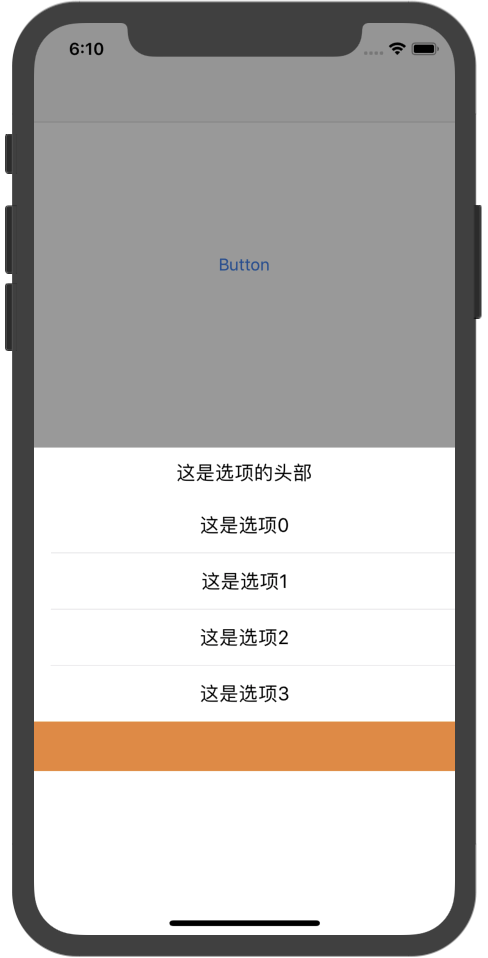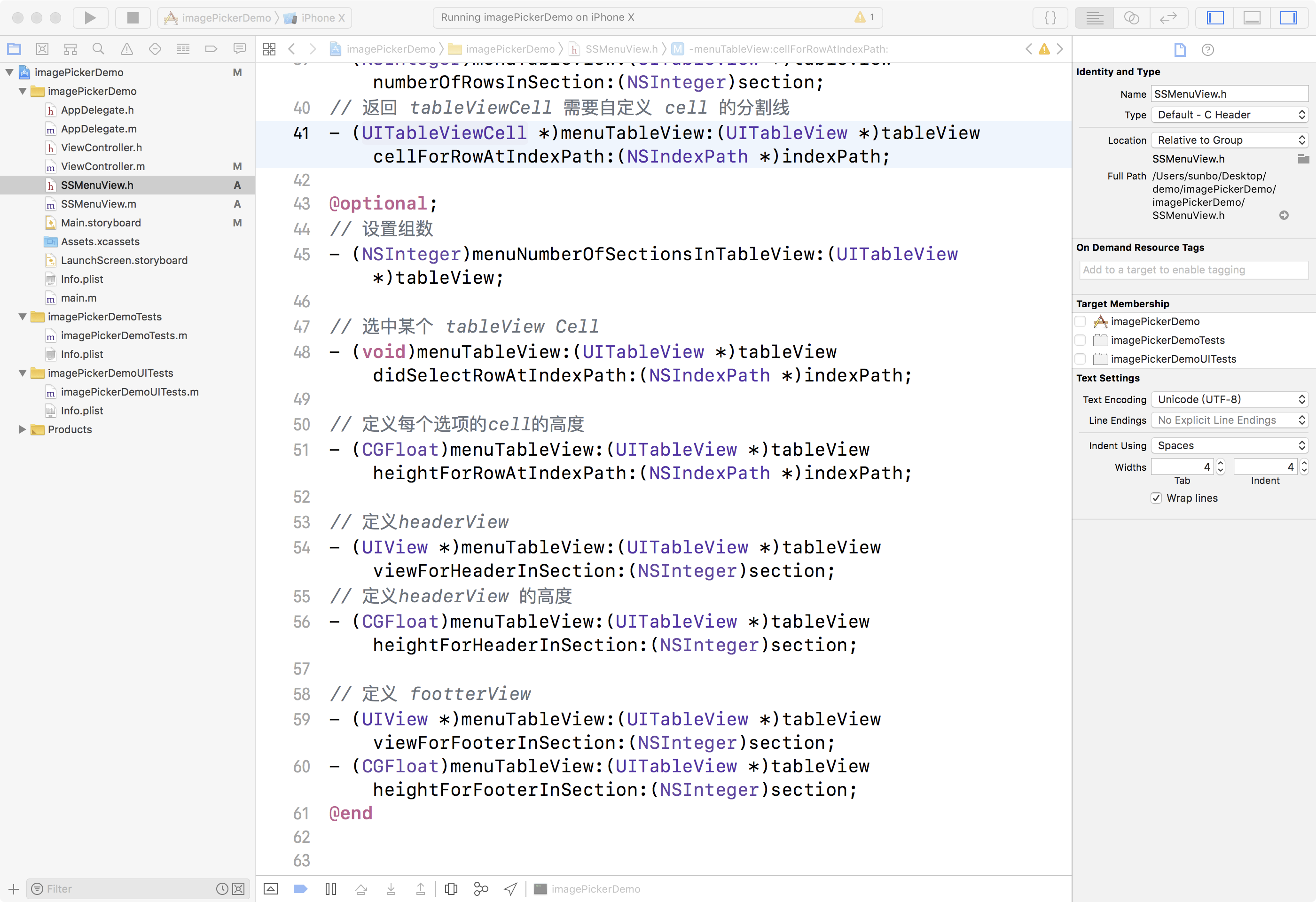技术: iOS Objective-C
概述
一个可以让开发者通过编写 tableView 的内容随心所欲的定制自己想要的底部弹框
详细
一. 运行效果图

二. 实现过程
1. 实现一个有遮罩效果的半透明 view,然后添加一个可设置展示内容高度的 contentView
// 这个遮罩是可以遮住全屏
- (void)createUI{
self.frame = CGRectMake(0, 0, SS_ScreenW, SS_ScreenH);
self.backgroundColor = [UIColor colorWithRed:0 green:0 blue:0 alpha:0.4];
self.userInteractionEnabled = YES;
[self addGestureRecognizer:[[UITapGestureRecognizer alloc] initWithTarget:self action:@selector(disMissView)]];
[self.contentView addSubview:self.tbView];
}
// contentView 是通过懒加载实现的
- (UIView *)contentView{
if (!_contentView) {
_contentView = [UIView new];
_contentView.backgroundColor = [UIColor whiteColor];
_contentView.frame = CGRectMake(0, SS_ScreenH - _contentHeight - SS_BottomMargin, SS_ScreenW, _contentHeight + SS_BottomMargin);
_contentView.opaque = YES;
[self addSubview:_contentView];
}
return _contentView;
}
2. 我们实现的底部弹框实质上一个可滑动的表单(tableView),在 contentView 上添加一个 tableView
- (UITableView *)tbView{
if (!_tbView) {
// _tbView = [[UITableView alloc]initWithFrame:CGRectZero style:UITableViewStyleGrouped];
_tbView = [UITableView new];
_tbView.delegate = self;
_tbView.dataSource = self;
[_tbView registerClass:[UITableViewCell class] forCellReuseIdentifier:@"ss"];
}
return _tbView;
}
3. 通过设置UIView 动画,实现遮罩 menuView 的展示和消失效果
// 将 menuView 展示在父 view 上
[view addSubview:self];
[view addSubview:self.contentView];
self.contentView.frame = CGRectMake(0, SS_ScreenH, SS_ScreenW, _contentHeight);
__weak typeof(self) weakSelf = self;
[UIView animateWithDuration:_animationDuration animations:^{
self.alpha = 1.0;
self.contentView.frame = CGRectMake(0, SS_ScreenH - weakSelf.contentHeight - SS_BottomMargin, SS_ScreenW, weakSelf.contentHeight + SS_BottomMargin);
} completion:^(BOOL finished) {
}];
// 将 menuView 从父 view 上移除
__weak typeof(self) weakSelf = self;
[UIView animateWithDuration:_animationDuration animations:^{
self.alpha = 0.0;
self.contentView.frame = CGRectMake(0, SS_ScreenH, SS_ScreenW, weakSelf.contentHeight);
} completion:^(BOOL finished) {
[self removeFromSuperview];
[self.contentView removeFromSuperview];
}];
4. 实现选项和头部的定制化
通过编写自己的代理方法,让开发人员根据自己项目的实际需要设置各个选项,并且可以定制固定的头部以及底部
@protocol SSMenuViewDelegate <NSObject>
@required;
// 返回 tableView 的行数
- (NSInteger)menuTableView:(UITableView *)tableView numberOfRowsInSection:(NSInteger)section;
// 返回 tableViewCell 需要自定义 cell 的分割线
- (UITableViewCell *)menuTableView:(UITableView *)tableView cellForRowAtIndexPath:(NSIndexPath *)indexPath;
@optional;
// 设置组数
- (NSInteger)menuNumberOfSectionsInTableView:(UITableView *)tableView;
// 选中某个 tableView Cell
- (void)menuTableView:(UITableView *)tableView didSelectRowAtIndexPath:(NSIndexPath *)indexPath;
// 定义每个选项的cell的高度
- (CGFloat)menuTableView:(UITableView *)tableView heightForRowAtIndexPath:(NSIndexPath *)indexPath;
// 定义headerView
- (UIView *)menuTableView:(UITableView *)tableView viewForHeaderInSection:(NSInteger)section;
// 定义headerView 的高度
- (CGFloat)menuTableView:(UITableView *)tableView heightForHeaderInSection:(NSInteger)section;
// 定义 footterView
- (UIView *)menuTableView:(UITableView *)tableView viewForFooterInSection:(NSInteger)section;
- (CGFloat)menuTableView:(UITableView *)tableView heightForFooterInSection:(NSInteger)section;
@end
三. 项目结构

四. 使用手册
1. 首先,根据目录,将 SSMenuView.h, SSMenuView.m 文件,添加到自己项目中
2. 创建弹框控件
由于在使用类似弹框的时候,用户可能会多次点击使用,为了避免重复创建,建议使用懒加载创建一个弹窗控件
# pragma
# pragma mark - Lazy -
- (SSMenuView *)menuView{
if (!_menuView) {
_menuView = [SSMenuView new];
_menuView.delegate = self;
// _menuView.contentHeight = 44 * 6;
// _menuView.tbView.separatorStyle = UITableViewCellSeparatorStyleNone;
}
return _menuView;
}
3. 根据自己的项目需要,创建自己的弹框内容
# pragma
# pragma mark - SSMenuViewDelegate -
- (NSInteger)menuTableView:(UITableView *)tableView numberOfRowsInSection:(NSInteger)section{
return 4;
}
- (UITableViewCell *)menuTableView:(UITableView *)tableView cellForRowAtIndexPath:(NSIndexPath *)indexPath{
UITableViewCell *cell = [tableView dequeueReusableCellWithIdentifier:@"cellID"];
if (!cell) {
cell = [[UITableViewCell alloc]initWithStyle:(UITableViewCellStyleDefault) reuseIdentifier:@"cellID"];
}
cell.textLabel.textAlignment = NSTextAlignmentCenter;
cell.textLabel.text = [NSString stringWithFormat:@"这是选项%ld",indexPath.row];
cell.selectionStyle = UITableViewCellSelectionStyleNone;
return cell;
}
- (CGFloat)menuTableView:(UITableView *)tableView heightForFooterInSection:(NSInteger)section{
return 44;
}
- (CGFloat)menuTableView:(UITableView *)tableView heightForHeaderInSection:(NSInteger)section{
return 44;
}
- (UIView *)menuTableView:(UITableView *)tableView viewForFooterInSection:(NSInteger)section{
UIView *footer = [UIView new];
footer.backgroundColor = [UIColor orangeColor];
return footer;
}
- (UIView *)menuTableView:(UITableView *)tableView viewForHeaderInSection:(NSInteger)section{
UIView *header = [UIView new];
header.backgroundColor = [UIColor whiteColor];
header.frame = CGRectMake(0, 0, [UIScreen mainScreen].bounds.size.width, 44);
UILabel *lab = [UILabel new];
lab.text = @"这是选项的头部";
[header addSubview:lab];
lab.textAlignment = NSTextAlignmentCenter;
lab.frame = header.frame;
return header;
}
4. 根据需要,在触发点击事件,弹出弹框
此处,有2种展示方式,根据开发者自己的需要选择是否将弹框完全全屏
- (IBAction)click:(id)sender {
// [self.menuView showInView:self.view];
[self.menuView showInWindow];
}
// 隐藏弹框
[self.menuView disMissView];
注:本文著作权归作者,由demo大师发表,拒绝转载,转载需要作者授权
来源:oschina
链接:https://my.oschina.net/u/4397620/blog/3619429